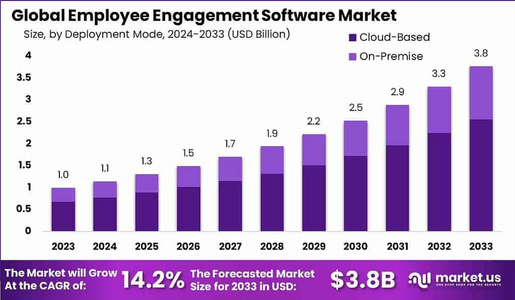Empowering Workforces: The Rise of the Global Employee Engagement Software Market
 Donna Coats
04 Jun, 2025
7 mins read
24
Donna Coats
04 Jun, 2025
7 mins read
24

Introduction
The global employee engagement software market is experiencing rapid expansion, driven by the increasing emphasis on employee satisfaction, productivity, and retention across various industries. Valued at USD 1.0 billion in 2023, the market is projected to surge to USD 3.8 billion by 2033, growing at a robust CAGR of 14.2% during the forecast period. As organizations seek to build resilient and motivated workforces, software solutions are evolving to support remote work, real-time feedback, performance management, and wellness programs. With digital transformation reshaping the modern workplace, employee engagement tools have become pivotal to organizational success and sustainability.
Key Takeaways
- The market is projected to grow at a CAGR of 14.2% from 2024 to 2033.
- It is expected to reach USD 3.8 billion by 2033, from USD 1.0 billion in 2023.
- North America led the market in 2023 with a 36.3% share and USD 0.4 billion revenue.
- Increasing adoption of remote and hybrid work models is a major growth driver.
- Real-time feedback and performance tracking tools are in high demand.
- Cloud-based platforms dominate due to scalability and integration ease.
- SMEs are showing rapid adoption, driven by affordable subscription models.
- Customization and user experience are key differentiators among providers.
- Integration with HRMS, payroll, and collaboration tools is becoming standard.
- Rising focus on mental wellness and DEI initiatives is influencing product design.
By Enterprise Analysis
Large enterprises are currently the leading adopters of employee engagement software due to their extensive workforce and complex organizational needs. They utilize these platforms for centralized feedback systems, performance analytics, and engagement tracking to enhance productivity and reduce turnover. However, small and medium-sized enterprises (SMEs) are witnessing accelerated adoption, especially with the availability of flexible, subscription-based, cloud-native solutions. The increasing affordability and usability of these platforms have democratized access, enabling even resource-constrained firms to harness technology to improve workplace culture and employee motivation.
By Industry Analysis
The IT and telecom sector is a major contributor to the growth of the employee engagement software market, owing to its dynamic work environments and tech-savvy workforce. Healthcare, BFSI, and education sectors are also rapidly embracing these platforms to improve communication, manage workforce morale, and track performance remotely. As industries face talent shortages and increasing demands for employee-centric policies, engagement software helps manage workforce expectations efficiently. Furthermore, sectors like retail and manufacturing are adopting these tools to bridge gaps between dispersed teams and frontline employees, improving overall organizational cohesion and productivity.
Market Segmentation
- By Deployment: Cloud-Based, On-Premise
- By Enterprise Size: Small & Medium Enterprises (SMEs), Large Enterprises
- By Industry: IT & Telecom, Healthcare, BFSI, Education, Retail, Manufacturing, Hospitality, Government, Real Estate, Logistics
- By Component: Solutions, Services
- By Function: Feedback & Survey, Goal Management, Recognition, Social Collaboration, Wellness & Health Tracking
- By End-User: Corporates, Non-Profits, Public Sector
- By Geography: North America, Europe, Asia Pacific, Latin America, Middle East & Africa
- By User Access: Web, Mobile
- By Integration: HRMS, Payroll, Collaboration Tools
- By Subscription Model: Monthly, Annual
Restraints
Despite robust market growth, several challenges may impede adoption. Data privacy and cybersecurity concerns pose significant barriers, especially when handling sensitive employee information. High implementation costs and complexity can deter smaller businesses from investing. Additionally, the lack of technical expertise and change resistance within organizations can hinder effective platform utilization. Integration with legacy systems and alignment with existing workflows also remain problematic. Moreover, the absence of industry-specific customization and inconsistent ROI measurement make it difficult for some enterprises to justify long-term investment in employee engagement software solutions.
SWOT Analysis
Strengths
- High demand for employee-centric solutions
- Strong market CAGR (14.2%)
- Broad integration capabilities with HR tools
- Scalability for both SMEs and large enterprises
Weaknesses
- High initial deployment and customization costs
- Data security and privacy concerns
- Resistance to digital adoption in traditional sectors
Opportunities
- Expansion in emerging markets and remote workforces
- Integration with AI and analytics for predictive insights
- Growing demand for wellness and DEI features
Threats
- Market saturation and pricing pressure
- Regulatory constraints around employee data
- Rapid technology changes requiring constant updates
Key Players (Non-Competitive)
- SAP SuccessFactors
- Workday
- BambooHR
- TINYpulse
- Culture Amp
- Officevibe
- Glint
- Lattice
- 15Five
- Kazoo
Recent Trends and Developments
- Integration of AI for personalized engagement insights
- Emphasis on mobile-first platforms for on-the-go usage
- Rise in wellness and burnout detection features
- Growing use of gamification to boost participation
- Real-time sentiment analysis through NLP integration
Conclusion
The global employee engagement software market is poised for substantial growth, fueled by workforce transformation and a growing emphasis on productivity, wellness, and employee experience. Organizations that invest now stand to gain significant long-term advantages.
Written By:
Donna Coats



Hotels at your convenience
Now choose your stay according to your preference. From finding a place for your dream destination or a mere weekend getaway to business accommodations or brief stay, we have got you covered. Explore hotels as per your mood.


